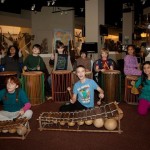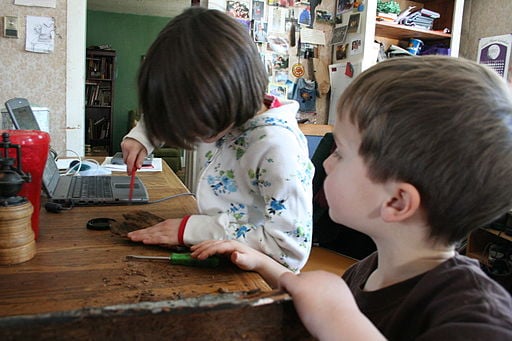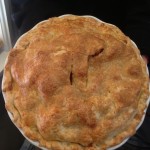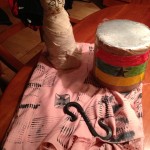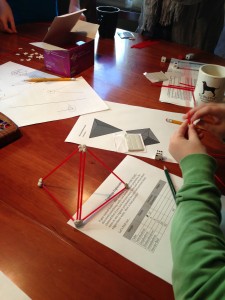 If I told you how many many edges and how many vertices were on a soccer ball, could you tell me how many faces were on it? No? Neither could I before a few weeks ago.
If I told you how many many edges and how many vertices were on a soccer ball, could you tell me how many faces were on it? No? Neither could I before a few weeks ago.
The boys take a math class taught by MIT grad students. When they had to miss one week, I asked the instructor to send me the problem for the week and we got together with our homeschool crew to work on it. The question was whether or not you could determine the number of faces on a polyhedron if you knew the number of sides and vertices.
It was great fun to watch the kids build shapes, count the sides, faces, and vertices, and discover the relationship between them. With a little help from the adults, the kids discovered Euler’s formula: V-E-2=F. How cool is that?
Ezra had to leave for an appointment just as they were determining the formula. When he came home, he burst through the door hollering, “Did they get it? What was the formula?”
Can you imagine math that is so captivating that a nine-year-old boy who is none too academically inclined would burst through door demanding to get right back to it?
Math that is necessary to help kids answer questions they are interested in is motivating. Now I’m not giving up on kill and drill. I still think that has its place, and my boys do some every morning. But there needs to be more than that if kids are going to stay interested in math and develop the habits of mind of mathematicians.
Next semester, along with the Western Expansion class, I am going to co-teach a math class from Interactive Mathematics Program, about the Overland Trail. The kids will form families on a wagon train and will have to plan for and execute the long trip across the country. Along the way, they will explore linear relationships in a deep way. The question – Can we survive this trip with this amount of supplies? – is motivating enough that kids will be excited about learning algebra.
I think of all of this today because we had the same group of kids over to start a unit on tiling floors from a book called Hard Math For Elementary School. We started out looking at Islamic tile patterns from the Berber kingdom, which we are studing in humanities. What are different ways to tile a floor with geometric shapes? What mathematical principles can we uncover as we work with the shapes? We met for an hour-and-a-half today and started to ask what kinds of shapes can be put together without leaving gaps in the pattern. Can you say fun?
 What else did we do today? You guessed it. We worked on those never-ending Africa projects before the math group. And then the whole group met some friends at the Frog Pond in Boston to go skating when it’s not crowded because everyone is at work or school. Ezra didn’t wear a coat in 35 degree weather. Is there some math to help me understand THAT?
What else did we do today? You guessed it. We worked on those never-ending Africa projects before the math group. And then the whole group met some friends at the Frog Pond in Boston to go skating when it’s not crowded because everyone is at work or school. Ezra didn’t wear a coat in 35 degree weather. Is there some math to help me understand THAT?


